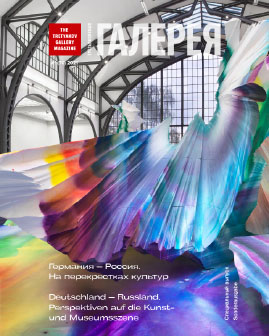CURRENT ISSUE - #1 2024 (82)
CURRENT EXHIBITIONS
The large-scale exhibition project “The Vasnetsovs. Across the Generations. From the 19th to the 21st Century” is timed to the 175th anniversary of the birth of the outstanding Russian artist Viktor Mikhailovich Vasnetsov (1848-1926) and the 100th anniversary of the birth of his grandson Andrei Vladimirovich (1924-2009). In the history of Russian culture there are not so many artistic dynasties that have contributed as much in its development as the Vasnetsovs. Bold innovators in painting, they opened up rich prospects for the art of the future.
HERITAGE
Viktor Mikhailovich Vasnetsov, one of the brightest artists of the turn of the 19th-20th centuries, formed a new folklore trend in the national art, his works to this day continue to influence our idea of what the heroes of Russian epic bylinas and fairy tales should look like.
MUSEUMS OF RUSSIA
Today the house of Viktor Mikhailovich Vasnetsov is a memorial museum, a research department of the State Tretyakov Gallery. The history of its creation covers the period from the beginning of construction of the house in 1894 to the opening of the museum in it in 1953. To this day, the house retains its inimitable appearance conveying the atmosphere of one of the unique corners of old Moscow, and the history of the museum is intertwined with the fates of its creators - the wife and children of the artist.
“GRANY” FOUNDATION PRESENTS
In the memorial museum of the artist Apollinary Mikhailovich Vasnetsov at 6 Furmanny Lane in Moscow, a small exposition, “At the Vasnetsovs’ Birthplace”, has been prepared as part of the exhibition “The Vasnetsovs. Across the Generations. From the 19th to the 21st Century”, which will be held in the halls of the New Tretyakov Gallery from 24 May to 4 November, 2024. One of the halls will show a series of graphic works, “My Homeland” (1918-1919, 1924), and memorial items from the collection of the artist's family associated with their birthplace, the village of Ryabovo in the Vyatka region.
HERITAGE
In the early 1890s, Apollinary Mikhailovich Vasnetsov began work on one of his major landscape cycles dedicated to the nature of the Middle and Southern Urals. To collect field material, the artist made two trips in 1890 and 1891. In the summer of 1890, at the invitation of his younger brother Arkady Mikhailovich Vasnetsov, he spent more than a month in the small factory town of Kushva in the Middle Urals. There he went on long journeys along the slopes of the nearby mountains, made pencil sketches and painted studies. The nature of the Urals reminded the artist of his native Vyatka land serving as a source of inspiration for many years.
MUSEUMS OF RUSSIA
Apollinary Vasnetsov, a landscape painter and explorer of Moscow, lived in the flat in Furmanny Lane for thirty years (1903-1933). In 1960, a memorial studio was opened in the artist’s flat and, in 1965, a memorial museum. The attractive atmosphere of the past and the multifaceted personality of the painter gather ever more new guests in the museum.
ART AND PERSONALITY
Andrei Vladimirovich Vasnetsov (1924-2009) is the famous grandson of the legendary great classic Viktor Mikhailovich Vasnetsov. The younger Vasnetsov’s name has been known since the second half of the 1950s: he was one of the leaders of young artists in the “thaw” movement, was among the first Russian masters to discover and promote contemporary style wedding form-building modernist ideas with the poetics of Russian painting. Despite repeated dressing-downs from the Communist Party, he did much to develop contemporary mural painting and monumental-decorative composition, combining vigorous modern rhythms and forms of expression with a humanist philosophy and free intellectual spirit. He also became one of the greatest teachers of the Russian art school in the second half of the 20th century - was head of the chair at Moscow’s Polygraphic Institute, which cohorts of his students graduated from. He was a full member of the Academy of Arts, had the title of the People’s Artist and was the last chairman of the USSR Union of Artists.












































